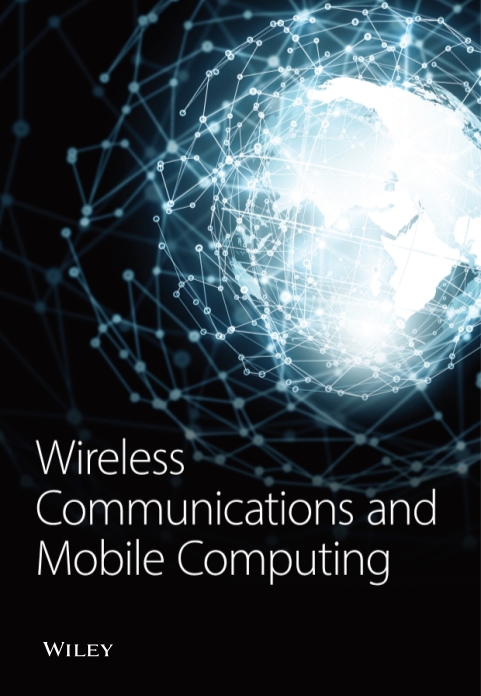[Retracted] The Development and Management Work Innovation of University Students by Artificial Intelligence and Deep Learning in the Wireless Network Era
Abstract
This study is aimed at promoting the growth and development of college students from two aspects: independent student learning and school management. Firstly, deep neural networks (DNNs) are used to build a personalized learning resource recommendation model for college students based on an online education platform. The model is tested and passed the experiment. A new comprehensive quality evaluation index system for college students is established in school management based on the traditional complete quality evaluation method. The thorough fuzzy evaluation (FCE) method and the backpropagation neural network (BPNN) model are combined to construct a comprehensive quality evaluation model for college students. The students’ comprehensive quality evaluation scores obtained using this model are compared with the actual scores through experiments. The results show that the number of learners is 50 in the constructed personalized learning resource recommendation model for college students. When the number of learning resources is 180, F1-score = 3 is more significant than other programs. The FCE method and the comprehensive quality evaluation model constructed by BPNN scored six students. The maximum error value between the evaluation result and the actual value is only 0.039. This shows that the effect of the constructed personalized learning resource recommendation model and college students’ comprehensive quality evaluation model is excellent and practical. This provides a feasible method for improving students’ independent learning ability and school management efficiency.
1. Introduction
As China’s major universities have achieved full coverage of wireless networks, relying on wireless network technology, university education, and teaching level has been continuously improved. The emergence of campus cards, online platforms, smart classrooms, and intelligent management systems has greatly helped improve the quality of students’ learning and life and the management level of the school. Students’ learning methods and school management methods have also changed with the transformation of teaching methods in higher education.
Yang et al. used Massive Open Online Course (MOOC) and self-paced Open Course (SPOC) network learning platforms to establish an intelligent management cloud platform for practical teaching. They provided a new functional teaching model for personalized learning based on artificial intelligence (AI) technology [1]. Wang studied and summarized the AI teaching system. He pointed out that AI’s application and development direction in the teaching field can be divided into three stages: preliminary application, intermediate application, and advanced application. College students’ ideological and political teaching system can be used as teaching management, teaching assistants, and even teaching objects to guide students’ learning based on mobile smart terminals [2]. Pucchio et al. studied the different AI and machine learning technology applications in medicine. They pointed out that medical students should be trained in AI and machine learning [3]. Ranavare and Kamath designed a chat robot used in the employment activities of college students based on AI technology [4]. Somasundaram et al. used AI and machine learning technology to analyze and predict student learning gaps based on the school’s past historical data and student files and performance and develop a personalized learning plan for each student. This can effectively improve the learning efficiency of students [5].
These research results have provided help for AI in student teaching and provided a valuable experience for research. However, these results are all to give students with learning resources or manage students’ learning to improve students’ learning efficiency. A lack of models can provide the students with accurate resource recommendations and control their overall quality. Firstly, this study constructed a personalized learning resource recommendation model for college students based on the deep learning network and college students’ online teaching platform research. Then, college students’ comprehensive quality evaluation model is constructed based on the backpropagation neural network (BPNN) and thorough fuzzy evaluation (FCE) method. Finally, the model is tested. AI technology is introduced into student learning development and management work, providing a feasible way for improving college students’ autonomous learning and management capabilities. These research results help improve the school’s management efficiency and facilitate the school to formulate personalized training programs for students.
2. Personalized Learning Recommendation Resources and Comprehensive Quality Evaluation of College Students
2.1. AI and Deep Learning Technology
AI [6] is the current focus of computer science and technology research, aiming to replace humans with complex tasks that require human intelligence to complete by simulating human thinking processes and intelligent behaviors by machines. AI technology can be applied in many fields, such as medical treatment, education, and transportation. This is of great significance for improving the technological level of modern society and the living standards of human beings.
Deep learning [7] is one of the essential technologies in the AI field, and it is a complex machine learning algorithm. Deep understanding gives the machine a certain amount of sample data to learn the laws and features existing in the sample. Then, the information obtained by learning is used to analyze and process data such as images, texts, and sounds. It has achieved excellent image processing, speech recognition, and natural language processing. Deep learning can make machines imitate the process of human audiovisual and thinking, provide convenient tools for solving many complex recognition problems in AI, and promote the further development of AI technology.
Deep neural networks (DNNs) [8], as the primary model of deep learning, have been widely concerned by scholars since the birth of deep understanding. The simplest DNN model is the perceptron model [9], as shown in Figure 1. It contains a simple model with several inputs and one output.
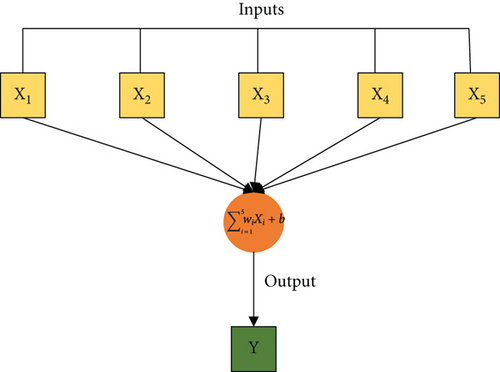
xi represents the input value, y represents the output, m represents the number of input values, wi is the linear relationship coefficient between xi and y, and b is a constant.
DNNs mainly include convolutional neural networks (CNN) [14], deep belief networks (DBN) [15], feedforward neural networks (FNN) [16], and recurrent neural networks (RNN) [17].
BPNN [18] is a multilayer feedforward neural network model of error backpropagation. During forward propagation, samples are passed from the input to the output layer. If the actual output value of the output layer is inconsistent with the expected output value, the error is propagated in the direction. In backpropagation, the output is passed back to the input layer by layer through the hidden layer in some form. The error is apportioned to all units in each layer, and the error signal of each layer unit is obtained. This error signal is used as the basis for correcting the weight of each unit. The network structure model is shown in Figure 2.
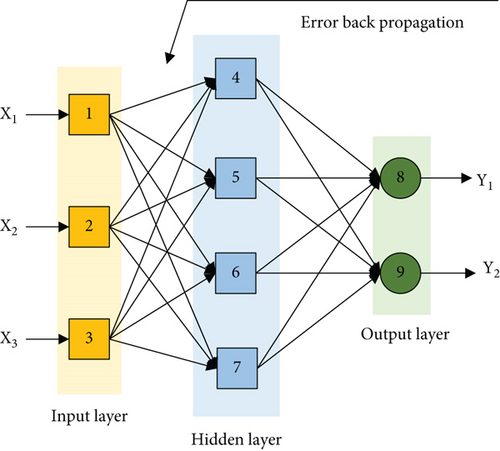
2.2. Personalized Learning Resource Recommendation
Learning is always the most important goal of students, and interest is the best teacher for learning. Growth and development are discovering interest and continuing to learn [19]. The study of college students is mainly based on autonomous learning, an essential stage for discovering interest, cultivating interest, and finding life goals. Nowadays, related research on online education in colleges and universities is relatively mature, but there are differences in different learners’ learning needs and learning abilities. The concept of personalized learning [20] is introduced based on online education to maximize the role of learning resources and improve the knowledge and effect of autonomous learning of college students through personalized learning resource recommendations to learners to meet learners’ differentiated learning needs.
Individualized learning refers to a learning method that promotes the individualized development of students based on the individualized differences of different students. Therefore, learners’ learning preferences and characteristics need to be analyzed to carry out personalized learning resource recommendations. Then, appropriate learning resources are recommended to the students. The study preferences and characteristics of students can be studied from the following aspects:
Professional choice: the university already has a relatively complete professional system, which can also be reflected in the online education platform for college students. Students can choose the major they want to study and then recommend the learning resources of the professional knowledge system according to the major selected by the student.
Learning ability: different students have different abilities to receive knowledge. The degree of difficulty of learning resources is also other under a unified knowledge system. Students are recommended appropriate learning resources for different knowledge acceptance abilities.
Study time: the study of school courses takes up most of college students’ time, so online research may not be sufficient. If a learning resource requires a long learning time, the learner may abandon the help. Studying time is also an essential consideration for college students in selecting learning resources.
Content type: different students also have preferences in learning resource types. Some students use the online education platform as an additional learning tool for their major to check the gaps and consolidate their knowledge to be interested in some related question-type videos. Some students want to learn new knowledge through online education platforms to discover resources for theoretical explanations.
Resource type: different learners have different kinds of resources they like. Some learners want to learn through video, while others like to learn through documents, animations, audio, and other methods. Recommending the types of learning resources will help improve learners’ learning experience according to learners’ preferences.
2.3. Construction of Personalized Learning Resource Recommendation Model
A personalized learning resource recommendation model is constructed. Firstly, the model focuses on students’ learning preferences and characteristics. The characteristics of learners and learning resources are matched by feature weighting. Then, multiple subobjective functions are constructed, and the relationship between the feature weight value and the recommendation result is studied. Finally, the DNN is designed. The DNN is used to realize the dynamic adjustment of the weight value, construct the multiobjective function, solve it, and obtain the personalized learning resource recommendation model sequence. The customized learning resource recommendation model is shown in Figure 3.
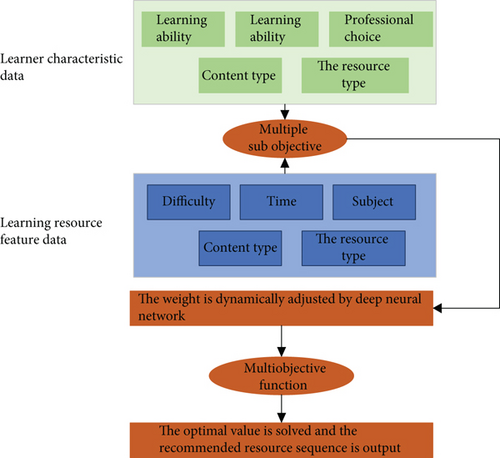
The personalized learning resource recommendation model is constructed according to Figure 3.
L represents the learner; LA represents the learning ability of the learner, LT represents the learning time of the learner, P represents the learning major chosen by the learner, and CLF and RLF, respectively, represent the content type and resource type that the learner likes. R represents the learning resource, D represents the difficulty of the resource, T represents the length of the resource, S represents the profession that the resource is suitable for, and CRF and RRF, respectively, represent the content type and resource type of the resource.
Then, the multiobjective function is constructed. Firstly, multiple subobjective functions are constructed according to the difference between the learner’s desired learning goals and requirements and the goals and requirements that the learning resources can meet. On this basis, a multiobjective function is constructed. Then, the multiobjective function is processed so that the final output result is 0 or 1.1 represents recommendation, and 0 represents not a recommendation.
C is the cost, w is the weight, b is the bias, n is the total number of samples, x is the sample, y is the actual value, a is the output value, and L is the number of layers in the neural network structure.
λ represents the regularization coefficient.
The workflow of the personalized learning resource recommendation model is shown in Figure 4.
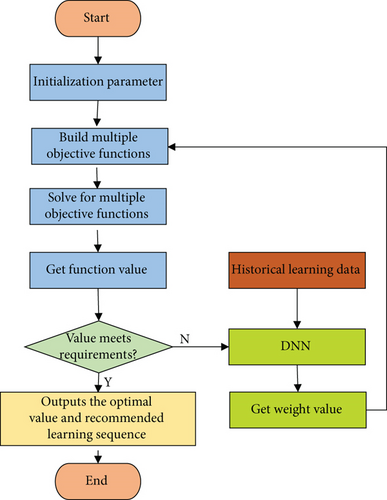
When the subobjective function constitutes a multiobjective function, the weight value is not fixed. When solving multiple objective function values, the minimum value of the procedure is optimized. This value satisfies the requirement when the small matter of the process tends to converge. At this point, the weight value will not be updated again. Finally, the optimal value of the function is output, and a recommended sequence of learning resources is obtained. If the requirement is not met, it will continue to be solved until the condition is met.
2.4. Evaluation Indicators for the Recommendation Model of Personalized Learning Resources
For the F1-score value [21], the output result is binary-processed when solving multiobjective functions combined with DNNs. One means a recommendation; 0 means not recommended. So, the F1-score value can be used for evaluation. This value reflects the accuracy and recall rate of the recommended method to a certain extent.
2.5. Evaluation Method of Comprehensive Quality of College Students
The growth and development of students are inseparable from the management and supervision of the school. The school will establish a management file for each student for comprehensive quality evaluation. The teacher can fully understand the students and provide students with more personalized education programs. Students can also help themselves achieve better self-management by checking the results of their comprehensive quality evaluation. Therefore, a reasonable and thorough assessment of the complete quality of college students can help schools better train students, help students continuously achieve self-improvement, and is of great significance to the growth and development of college students. Based on the traditional comprehensive quality evaluation method of college students, BPNN and FCE methods are combined to construct college students’ comprehensive quality evaluation model.
Firstly, the evaluation index system is established [22]. The evaluation of the comprehensive quality of college students needs to meet the principles of scientificity, comprehensiveness, feasibility, independence, fairness, and rationality. The evaluation of students’ comprehensive quality includes five aspects, ideological and political and moral cultivation, scientific and cultural qualities, ability qualities, humanity qualities, and physical and mental qualities. These five items serve as the first-level indicators of the evaluation system. Ideological and moral quality can be embodied in three aspects: political quality, moral quality, and legal quality. These three items are used as secondary indicators. The secondary indicators of scientific and cultural quality include basic public courses, professional courses, elective courses, practical courses, foreign language skills, and computer skills. The secondary indicators of ability and quality include basic knowledge and unique ability. The secondary indicators of physical and mental quality are physical fitness and psychological quality. The secondary indicators of humanistic quality are cultivating humanistic qualities, participation in cultural competitions, and participation in club activities.
Then, the index weight is determined [23]. The analytic hierarchy process (AHP) [24] determines the index weight. The first step is to construct the comparison judgment matrix. According to the 1-9 scale method [25], the importance of all evaluation indicators is compared, as shown in Table 1.
| Scale number | Meaning | Scale number | Meaning |
|---|---|---|---|
| 1 | Two factors are equally important | 2 (4, 6, 8, 1/2, 1/4, 1/6, 1/8) | The median value of other adjacent judgments |
| 3 | One is slightly more important than the other | 1/3 | One is somewhat less important than the other |
| 5 | One is more important than the other | 1/5 | One is less important than the other |
| 7 | One is stronger than the other | 1/7 | One is stronger than the other is not important |
| 9 | One is more important than the other extreme | 1/9 | One is less important than the other extreme |
The index weight is determined by AHP, and the weight judgment matrix is obtained by comparing two. In addition, the judgment matrix is calculated and normalized to calculate the priority of the scheme layer in the target layer, and the consistency ratio index Consistency Ratio (CR) is less than 0.1. It shows that the test results pass the consistency test, and finally, the weight of each index is obtained (Figure 5).
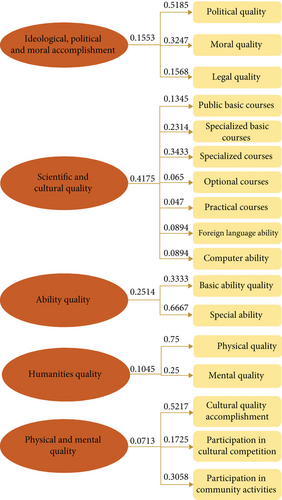
2.6. The Construction of FCE Model of College Students’ Comprehensive Quality Based on BP Neural Network
The FCE method [26] can make an overall evaluation of things or objects restricted by multiple factors. The FCE method is introduced into college students’ comprehensive quality evaluation model. The specific construction steps are as follows: firstly, perform the evaluation transformation according to the FCE method to obtain the fuzzy evaluation relationship of variety shows. Then, different evaluation levels are assigned points. Finally, the score is calculated. The calculated score is used as the input value of the BPNN, and the score of each index is used as the input neuron to train the BPNN. The test sample is used to compare the total evaluation score output by the BPNN with the evaluation effect of the actual result test model.
3. Results
3.1. Analysis of Personalized Learning Resource Recommendation Model
For experimental setup, design four schemes and conduct experiments in six experimental groups. The four schemes are as follows: Plan 1 is the adaptive weight value obtained by the DNN, Plan 2 is the weighted average processing method, Plan 3 is the weight processing method of random size, and Plan 4 refers to the fixed weight processing method set by previous researches. The experimental group setup is shown in Figure 6.
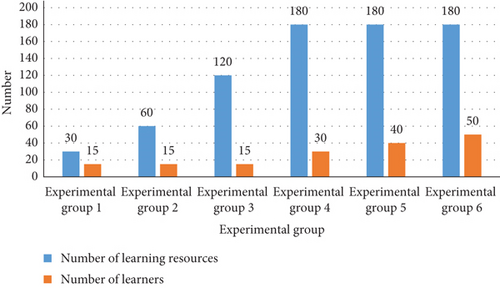
Figure 6 shows the number of learning resources and the number of learners in the six experimental groups.
In Figure 6, the six experimental groups are control groups, and the number of learners in experimental groups 1, 2, and 3 is the same, 15 people. The number of learning resources is increasing. By comparing the experimental groups 1, 2, and 3, when the number of learning resources increases, the model’s use effect and performance are investigated. Experimental groups 4, 5, and 6 had the same number of learning resources, 180. The number of learners is increasing, and using the model can be studied when the number of learners increases.
Figure 7 shows how the four schemes solve the multiobjective function values when iterations are 50, 100, 150, and 200, respectively.
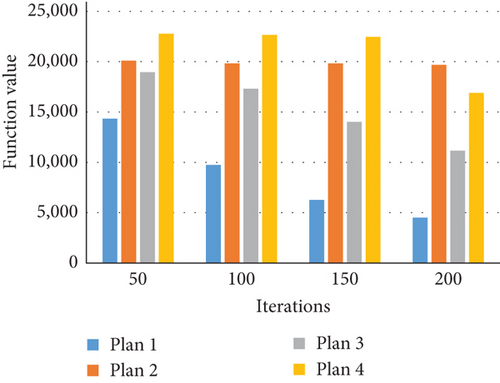

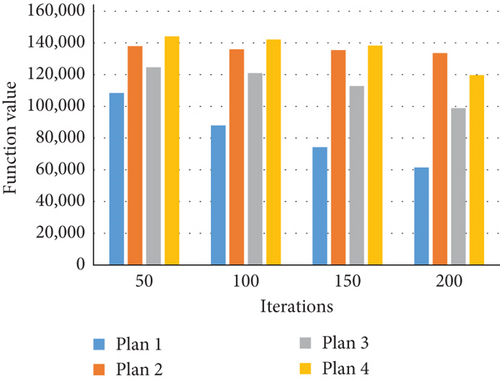
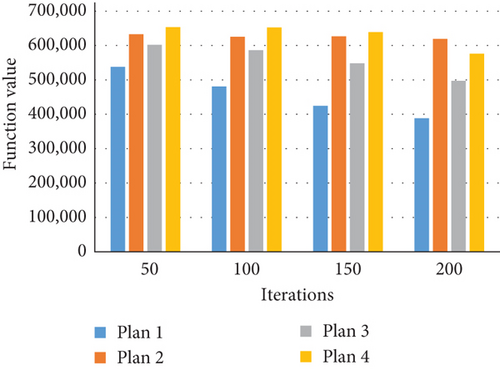
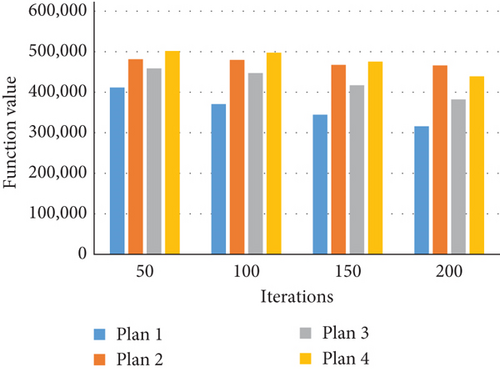
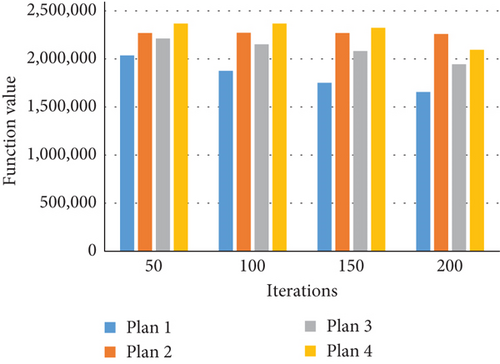
The data statistics are shown in Table 2.
| Experimental group | Iterations | Plan 1 | Plan 2 | Plan 3 | Plan 4 |
|---|---|---|---|---|---|
| Experimental group 1 | 50 | 14328.43338 | 20098.30989 | 18951.05026 | 22773.38358 |
| 100 | 9744.99123 | 19829.68324 | 17311.30844 | 22661.45581 | |
| 150 | 6264.03761 | 19829.68324 | 14026.22841 | 22465.58221 | |
| 200 | 4506.77163 | 19678.58076 | 11155.28113 | 16891.5793 | |
| Experimental group 2 | 50 | 60665.73662 | 83294.79008 | 70879.88993 | 90300.22089 |
| 100 | 47444.45594 | 82706.80428 | 67318.37595 | 89258.64604 | |
| 150 | 38826.26409 | 82589.20712 | 57557.81168 | 81564.43187 | |
| 200 | 32291.22192 | 81110.84283 | 49746.00036 | 68931.13699 | |
| Experimental group 3 | 50 | 108451.6516 | 137929.8603 | 124603.0395 | 144066.8741 |
| 100 | 87960.70168 | 135978.3413 | 120905.4245 | 142115.3551 | |
| 150 | 74274.3905 | 135464.7836 | 112842.5695 | 138263.6728 | |
| 200 | 61486.8052 | 133538.9425 | 98822.44582 | 119672.8861 | |
| Experimental group 4 | 50 | 537933.3765 | 632629.4257 | 602164.8728 | 653517.0459 |
| 100 | 480967.1393 | 625281.6067 | 586395.9579 | 652361.2093 | |
| 150 | 424661.3804 | 626437.4434 | 548088.2274 | 638821.408 | |
| 200 | 388582.7635 | 619089.6244 | 497313.9726 | 576241.1069 | |
| Experimental group 5 | 50 | 411559.415 | 481209.6283 | 458528.9458 | 501672.1511 |
| 100 | 370689.8233 | 479712.3705 | 447160.8775 | 497513.1018 | |
| 150 | 344570.9933 | 467235.2224 | 417215.7221 | 475553.3212 | |
| 200 | 315790.3717 | 466070.6886 | 382002.4375 | 439230.9567 | |
| Experimental group 6 | 50 | 2035868.373 | 2268338.818 | 2211773.309 | 2367213.488 |
| 100 | 1875829.372 | 2271328.052 | 2151988.625 | 2367213.488 | |
| 150 | 1751661.182 | 2268338.818 | 2081396.709 | 2323294.739 | |
| 200 | 1656005.688 | 2258911.233 | 1944811.7 | 2094043.469 | |
In Figure 7 and Table 2, when the number of learners remains unchanged, and the number of learning resources increases, the size of the multiobjective function value also increases. When the number of learning resources remains intact and the number of learners increases, the built-in DNN personalized learning resource recommendation model still performs well. As the number of learners and resources increases simultaneously, Plan 1 is more adaptable to solve multiobjective function values. This shows that the constructed DNN personalized learning resource recommendation model can meet the learners’ expectations.
In Figure 8, from experimental group 1 to experimental group 6, as the number of learners and the number of learning resources increase, the F1-score value keeps increasing. For experimental group 1, experimental group 2, and experimental group 3, because of the small number of samples, their F1-score value is low. The F1-score values of experimental group 4, experimental group 5, and experimental group 6 are all above 1 and increase with the number of samples. Plan 1 has more tremendous advantages compared to other projects. In experimental group 6 experiments, the F1-score value of Plan 1 is 3, which is the maximum of the four schemes. This shows that using DNNs to adjust the weight value dynamically can effectively promote the recommendation effect of the personalized learning resource recommendation model.
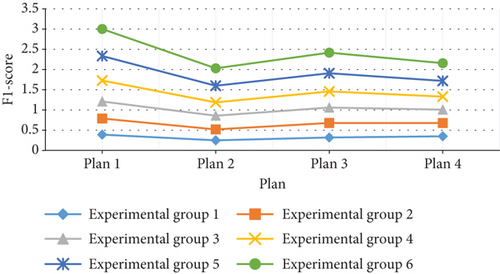
3.2. Analysis of the Comprehensive Quality Evaluation Model of College Students
Six people A, B, C, D, E, and F are randomly selected from the second-year list of Xi’an University of Technology. The built model is used to calculate their total quality evaluation score and the error value between it and the actual score, as shown in Figure 9.
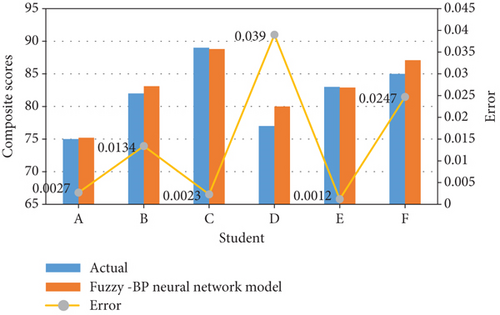
In Figure 9, the scores of college students’ comprehensive quality evaluation model using the constructed fuzzy-BPNN are not much different from the actual scores. The maximum error value is 0.039, and other errors are less than this. Therefore, the model has good generalization ability.
4. Conclusion
In order to promote the comprehensive and healthy growth and development of college students, AI technology has been introduced into the study and management of students. Through the research on personalized learning resource recommendation, a personalized learning resource recommendation model for college students is constructed based on college students’ online education platform and the DNN model. The model is studied and analyzed through experiments. In order to improve the efficiency of the school’s management of student work, the BPNN model and FCE are introduced into the comprehensive quality evaluation management of college students, and the total quality evaluation model of college students is constructed. The constructed model is compared with the actual score through the experiment. The results show that college students’ constructed personalized learning recommendation model is more adaptable for solving multiobjective function values. In a larger sample with 50 learners and 180 learning resources, the F1-score value of this model is 3, which is greater than the F1-score = 3 of other schemes. This shows that the recommendation effect of this program is better than that of other programs, and it can meet the learning expectations of learners. The FCE method and the comprehensive quality evaluation model constructed by the BPNN scored six students, respectively, and the maximum error value between the result and the actual value is 0.039. This shows that the model has good generalization ability and practicality. The research results provide a feasible method for improving the management efficiency of the school and promoting the excellent development of students. But some shortcomings still exist: (1) the index division of the comprehensive quality evaluation of college students is not detailed enough, and there are few places. This will cause many students to score the same in the same indicator. (2) The application of the comprehensive quality evaluation of college students has not been studied. The thorough quality evaluation of college students can help the school manage students scientifically to a certain extent, and it can also provide help for students’ employment planning. (3) A personalized learning resource recommendation model must collect and record learner characteristics to achieve accurate recommendations. Here, the training samples are insufficient, the summary of the learner’s elements is relatively general, and specific errors may occur in the actual proposal. The comprehensive quality evaluation model of college students constructed does not solve the BP neural network which easily falls into local optimum. In the future, these aspects will be further studied.
Conflicts of Interest
No conflicts of interest exist concerning this study.
Acknowledgments
This work was supported by Scientific Research Project of Inner Mongolia Colleges and Universities, research on current situation of cultural security in colleges and universities in the new media era (Project No. NJSY20308).
Open Research
Data Availability
The data used to support the findings of this study are included within the article.



